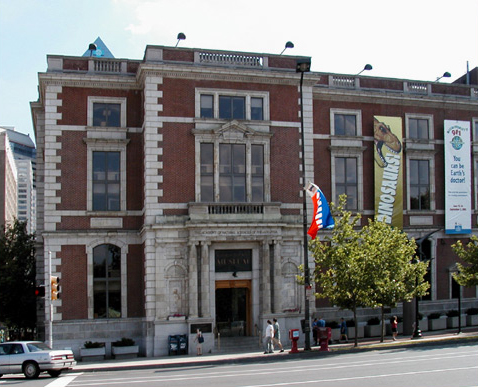Lewis’s Herbarium
The Academy of Natural Sciences, founded in 1812, moved into its imposing building on the south side of Logan Circle in 1876. As the oldest research institute in the Western hemisphere, it has a long history of participation in scientific investigation.
The Academy’s monumental collection of scientific specimens includes the Lewis and Clark Herbarium, consisting of all the botanical specimens the Expedition brought back East. Lewis gave them to Benjamin Smith Barton, who was to have published a book on the natural history of the Expedition, but Lewis died in 1809, and Barton died in 1815, with the book still unwritten. Lewis’s herbarium was then deposited at the American Philosophical Society, where it lay almost entirely forgotten for nearly eighty years, until Thomas Meehan stumbled upon it, and arranged for the APS to loan it to the Academy of Natural Sciences, where it could be systematically studied and conserved.[1]For a brief account of Thomas Meehan’s role in the preservation of the Lewis and Clark Herbarium at the ANS, plus a discussion of one of the specimens it contains, see Lewis’s Specimen of … Continue reading
Long’s Expedition
Shortly after its founding in 1812, the ANS contributed to the exploration of western territories. A successor of the Corps of Discovery, the Scientific Expedition of 1819, was ordered by the Secretary of War John Caldwell Calhoun (1782-1850) “to explore the Missouri River and its . . . branches.” The leader of the expedition, Stephen Harriman Long, one of the army’s early topographical engineers, considered that he was expanding the Lewis and Clark exploration. Calhoun requested that the American Philosophical Society advise on what the expedition should be looking for, and suggested that Long read Jefferson’s instructions to Lewis.
That document was to be found on pages xiii-xx of the letter titled “Memoir of Meriwether Lewis” which the President wrote at the request of Paul Allen, as an introduction to Nicholas Biddle‘s paraphrase of the Expedition’s journals as then known, published in 1814 as the 2-volume History of the Expedition under the Command of Lewis and Clark.
Long’s plan included the design and construction of a steamboat to ascend the Missouri. Experience with the boat was reminiscent of that experienced by Lewis with his “iron boat,” but more consequential. It caused delay, breakdown and abandonment of the expedition near present-day Omaha.
Notes
| ↑1 | For a brief account of Thomas Meehan’s role in the preservation of the Lewis and Clark Herbarium at the ANS, plus a discussion of one of the specimens it contains, see Lewis’s Specimen of the Bitterroot plant. See also Lewis’s Plant Collection. |
|---|
Experience the Lewis and Clark Trail
The Lewis and Clark Trail Experience—our sister site at lewisandclark.travel—connects the world to people and places on the Lewis and Clark Trail.
Discover More
- The Lewis and Clark Expedition: Day by Day by Gary E. Moulton (University of Nebraska Press, 2018). The story in prose, 14 May 1804–23 September 1806.
- The Lewis and Clark Journals: An American Epic of Discovery (abridged) by Gary E. Moulton (University of Nebraska Press, 2003). Selected journal excerpts, 14 May 1804–23 September 1806.
- The Lewis and Clark Journals. by Gary E. Moulton (University of Nebraska Press, 1983–2001). The complete story in 13 volumes.


